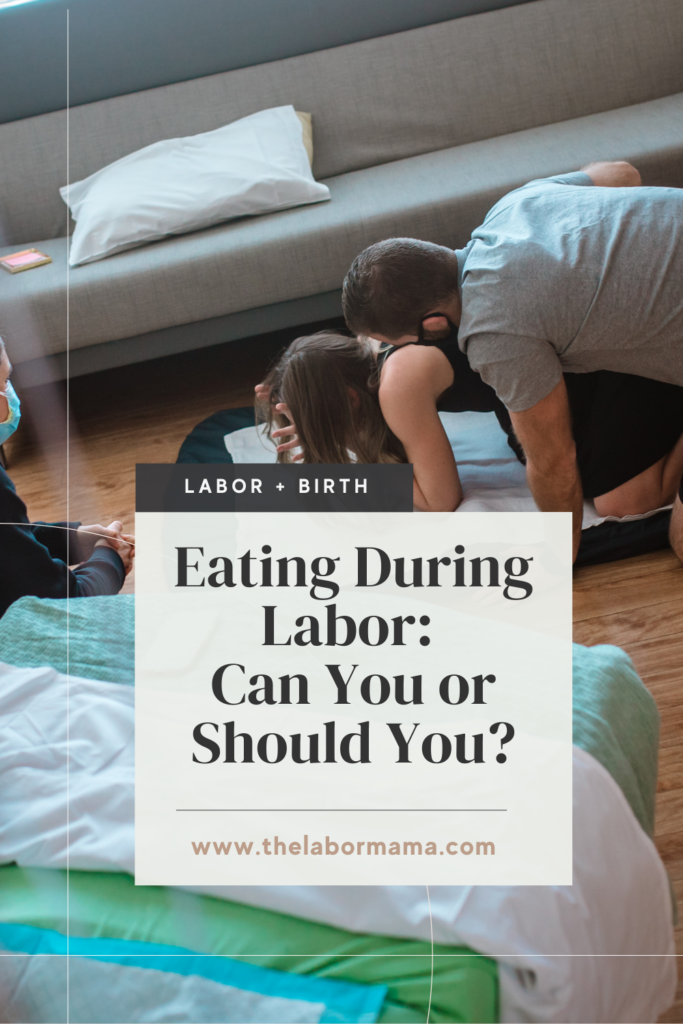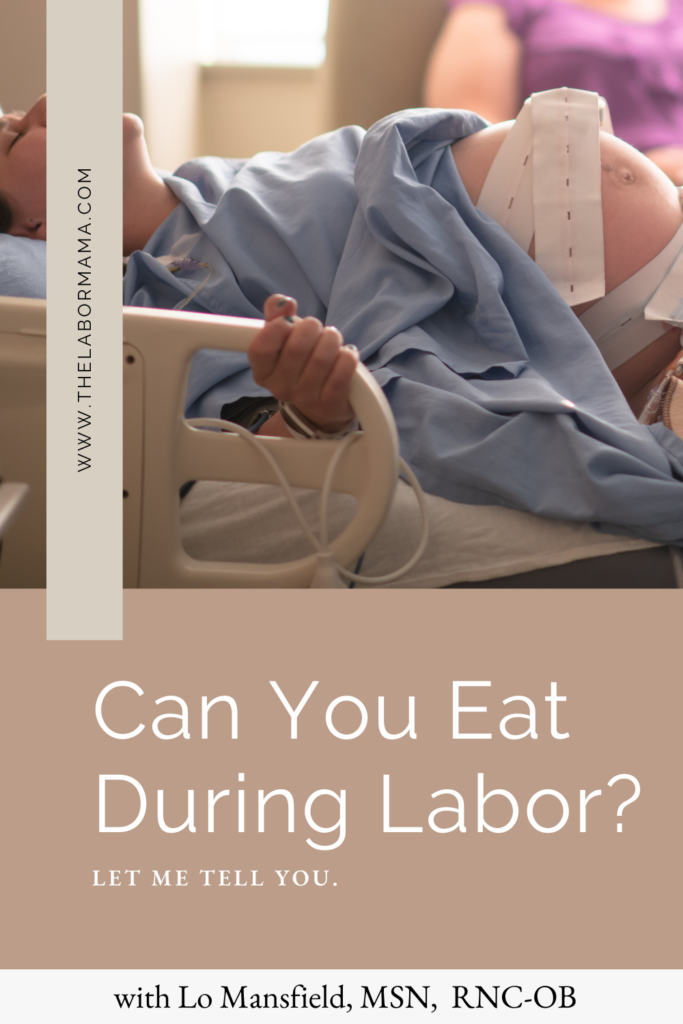If you are pregnant and doing some learning, you have likely googled the question why can’t you eat during labor? No eating during labor is a common rule in many hospitals, but a lot of people accept the rule without really understanding where it is coming from or if it is evidence-based. Let’s change that, yah? Whether or not you plan on eating, I want you to know what’s going on behind this conversation.
Maybe, you’ve already had someone tell you that they couldn’t eat during their labor. Maybe, your provider has already loosely mentioned in a prenatal appointment that you can’t eat either. Or maybe, all you remember from your first baby is how hungry you were during your 26-hour marathon labor and birth – AND NO ONE WOULD LET YOU EAT! Whatever experiences you do or don’t have with this, let’s make sure you understand it better. Can you eat during labor? Where does the “you can’t eat in labor” rule come from? And if you can eat, what are good labor snacks or best foods for labor? Here we go.

But before we dive into eating during labor – Who is The Labor Mama and Why Am I Here?
Hey friend! I’m Lo – also known around here and social media as The Labor Mama. I’ve spent my nursing career in labor, delivery, and postpartum, have birthed 4 of my own babies, have labored thousands of mamas at the bedside, have taught thousands of students online, and have even delivered a few speedy little babies with my bare hands (oops).
Here at TLM, I offer online classes about birth, postpartum, newborn care, and breastfeeding to empower you the way everyone should be. The education + support I offer gives you experience, evidence, and empathy; you’re getting all of my years of “clinical” RN knowledge, honestly combined with my real experiences as a mama, nurse, and CLC. These are not your average hospital classes (those won’t do it, I promise), and honestly, birth, postpartum, and breastfeeding don’t follow a textbook or protocol anyway. You need to know so much more than that!
If you want to connect with me further, head to Instagram. There are hundreds of thousands of us over there learning together daily.
A note: This post may include affiliate links. This means if you make a purchase after clicking a link, I will earn a small commission (thank you)! Rest assured, this comes at no additional cost to you. You can read TLM’s full disclosure here.
Some history on eating during labor
Ok, so the practice of eating (or not) in a hospital has a medical term associated with it – NPO. NPO comes from the Latin term nil per os, which means nothing by mouth. When a laboring patient is NPO, this means they can’t eat or drink anything solid (clear liquids like water, energy drinks, popsicles, or broths may be ok) until after the baby is born. This restriction of food and drink is an incredibly common practice in US hospitals, and has been for some time.
In recent years, the practice has been getting a ton of pushback – and it’s easy to see why. Labor is a long, physical process! Obviously, there are a ton of mamas who are extremely hungry or thirsty at some point in these labor and birth hours. And we have to think that some food or snacks for labor could do wonders in supplying the body some much-needed physical energy. The average human body has needs. The laboring human body has even more. Does science really support withholding calories and energy from mamas as “best practice?”
Has eating during labor always been a no-no?
The NPO practice began in the 1940s, when the labor and birth process looked SO different. NPO is supposed to protect patients against something called aspiration. Aspiration occurs when someone who is under general anesthesia (this means they’re asleep) vomits their stomach contents into their mouth. When this happens, those contents can then be aspirated back down the “wrong” pipe (the airway) and this can lead to lots of issues with the lungs, including infection, significant breathing complications, and sometimes, death.
In the 1940s, anesthesia for labor was pretty primitive. Many patients delivered via Twilight Sleep, which was a drug combination that caused sedation and memory loss. When anesthesia was needed for instrumental delivery (like forceps) or episiotomy, inhaled gases like chloroform were used, with little ability to be safe or precise. They also did not consistently use tools that safely kept patient airways open (like a laryngoscope). Basically, the medical anesthesia practices of birth were dangerous, and aspiration was much more common than it is in the labor and birth world today.
In 1946, the research responsible for the NPO culture of birth was published. In the work, Dr. Mendelson found that patients given general anesthesia during birth could inhale their stomach contents – and that in rare cases it could lead to infection or death. His conclusions were that we could avoid this risk via NPO policies – and that when possible, local anesthesia should be used instead of general anesthesia.
Does evidence support not eating during labor?
Fast forward 80 years, and it makes sense that we consider what has changed (in practice) and whether or not old routines and rules are still supported by current research. Anesthesia practices have changed SO much. Drug concentrations and medication delivery are much more precise and safe. Intubation and airways tools are way better. And general anesthesia is used way less! Does an NPO policy still make sense?
There have been quite a few studies that have looked at aspiration risks in the last couple of decades. These studies have looked at risk of death and illness related to aspiration – and both are occurring in incredibly small amounts. Some argue that the low rate of aspiration events is because NPO policies permeate the hospital culture. But, there are countries who have gotten rid of their NPO policies and seen no more aspiration events than others. Evidence Based Birth has a wonderful write up about this whole topic and it details each one of these studies and their results.
Does your body need to eat during labor?
Aside from the science behind anesthesia safety and labor, what about what the body needs during labor? Many liken the process of labor to running a marathon, which would mean the body (and that uterine muscle) have intense caloric needs. Carbohydrates become increasingly necessary during periods of extended exercise, because they can improve the “performance” of the body and protect against fatigue. FYI: maternal exhaustion is a common reason of unplanned cesarean birth.
Though evidence isn’t clear on what a person in labor needs to eat and drink to meet their energy needs (simply because it hasn’t been done yet), many assume that if a marathon runner has specific weight-based carbohydrate needs to successfully run their race, than we can make the same assumption for a laboring mama too.
So, can you eat during labor?
Ok, if you’re keeping up, you know now that a huge part of aspiration risk is general anesthesia. Though common in earlier decades, general is rarely used in labor and birth today. When a patient does need general anesthesia, there are a variety of safety practices now in place (like meds to reduce stomach acidity and great airway tools) that further decreases anesthesia risks as compared to those that existed in the 1940s.
Recent research now supports that healthy low-risk people actually benefit from a light meal in labor. That research found one case of aspiration in the US between 2005 and 2013 – and it occurred in a high risk patient. Additionally, the research findings showed that NPO policies can actually lead to ketosis, which makes the stomach juices acidic and potentially more dangerous if they were aspirated.
If a patient is higher risk (hypertension issues, elevated BMI, the use of IV pain medications in labor etc.), this conversation of what is appropriate may be different. But for the low-risk population, the risk of aspiration under general anesthesia is incredibly low. Palmer and Jiang (2022) state “The actual incidence of the complication is so low, we cannot accurately describe it.”
And then per Rebecca’s summary from Evidence Based Birth: “The researchers … concluded that “Nothing by Mouth” is an outdated restriction that should not be applied to low-risk people giving birth today. Their findings were echoed in a 2016 opinion paper published by Sperling et al. in the American Journal of Obstetrics and Gynecology.”
What do the organizations officially say?
Here’s the fun part. There is still little clarity on whether you can or cannot eat during labor. It also gets confusing as you start to discuss what IS okay: solid foods, clear liquids, any liquids, light snacks, etc. Food and/or drink can technically mean a lot of things – and it can be really frustrating to not know what exactly is being recommended or prescribed. The best thing you can do right now is learn about it, and then go have a good convo with your provider about it – specific to you.
Interestingly, the American Society of Anesthesiologists (ASA), despite having the above research about aspiration presented at one of their meetings, does not support eating solid foods in labor. But, both they and American College of Obstetricians and Gynecologists (ACOG) support laboring people be allowed access to clear liquids (meaning way more than ice chips or sips of water). Here are the opinions of a few other different governing bodies:
- The WHO: low-risk to eat or drink as desired in labor
- The American College of Nurse Midwives: low-risk to eat or drink as desired in labor
- The Society of Obstetricians and Gynecologists of Canada: low-risk to eat or drink as desired in labor
- The American Journal of Obstetrics and Gynecology Maternal-Fetal Medicine: no evidence to support restrictions of oral intake
Right now, ACOG does state that their current recommendation (access to liquids, but no solids) has questionable evidence to support it and it is under review.

Best foods for labor
Ok, let’s assume you are someone who is free to do some light eating during labor. What are some good snacks for labor? Are there any foods that may make labor easier? There actually isn’t any research about this topic. Foods and drinks that are high in carbohydrates are popular, since they can offer that quick hit of energy that the laboring body may need. Here’s a list of common snacks for labor (and drinks). I’m going to separate them out into early labor + active labor. Personally, I am never interested in eating during labor (especially active labor). But if you can eat in early labor (which, on average, can be about 12 hours long), I would try to get your body some energy.
Remember, these are just ideas. I don’t know that there truly are “best foods for labor.” We’re all too different for that! But, I do like to consider easy prep items that you can chew or drink easily and quickly and/or eat with one hand. Overall, follow your own impulses and feelings for what sounds good.
Early labor snacks + food
- scrambled eggs
- oatmeal (with some fats/carbs like brown sugar or butter)
- smoothies
- nut butter on toast
- lactation cookies
- fruits: bananas, melons, berries, dates
- yogurt cup with granola/fruit
- whole wheat pasta or rice
Active labor snacks + food
- energy/high carb fluids (like gatorade or powerade) (you can also freeze the as ice cubes to suck on)
- honey sticks
- fresh fruit juices
- coconut water
- simple broths: bone, veggie, miso, chicken
- popsicles/jello
- graham crackers/saltines
- labor-aide
More for you here on this topic: 18 Best Snacks to Pack in Your Hospital Bag
The takeaway on eating during labor
Eating during labor sound like something you want? To be honest, me too. The best thing you can do right now is have a conversation with your provider about what their recommendations are, any hospital policies, and how you feel/what you’d like. Read the evidence. Know your own health history and level of risk. Be confident in your feelings! It’s so important to have these convos before labor begins, so that you can plan (and pack) well and walk into your birth space knowing you are all on the same page.
Did you eat during labor? Do you hope to? Let me know in the comments! I’d love to hear your story on this. xx – Lo

More resources (and freebies!) for you to take a peek at:




